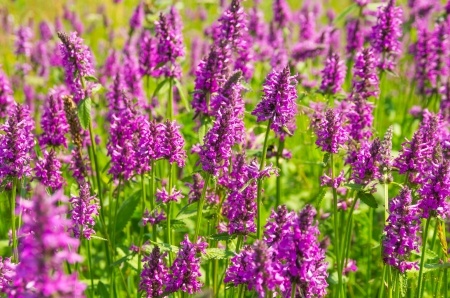Purple Betony – Betonica officinalis

Common Names: Purple Betony, Wood Betony, Bishopwort, Bishop's Wort, Betony, Betonica officinalis, Stachys officinalis, Betoine, Betonie, Global Betony
Latin Name: Betonica officinalis
Origin: Africa, Asia, Europe, South America, North America
Short Introduction
If you decide to cultivate Purple Betony at home, you can use seeds from specialty shops or from wild-growing plants (just ensure they are not collected from areas near roads or places with high exhaust fumes). The whole inflorescence can be dried outdoors in direct sunlight, ideally in well-sealed containers. When growing Purple Betony outside or in pots, prioritize moist, humus-rich soils that are neutral to slightly alkaline. Purple Betony is native to Europe.
Detailed Description
Purple Betony is a plant renowned for its almost magical effects on a range of conditions involving the stomach, intestines, and respiratory system.
Botanical Information
Purple Betony (Betonica officinalis) is a perennial herb that typically reaches a height between 20–60 cm, although it can occasionally grow up to 80 cm. It has a thickened or woody rhizome at the base, a straight, unbranched, and hairy stem, along with elongated, ovate leaves—those at the base being long-petioled. The carmine-red flowers are densely arranged in spike-like inflorescences and bloom from July to August.
Origin and Distribution
Purple Betony is found throughout most of Europe, from the northern Baltic region and southern Scandinavia and the British Isles to the foothills of the Urals and Caucasus in the east, as well as North Africa, Asia Minor, North America, and parts of Asia. In Africa, it grows from Tunisia to Morocco, and it's widespread in North America as well.
Although not originally native across all of Europe, Purple Betony is now widespread, including throughout the Czech Republic, from lowlands to uplands (up to about 700 meters above sea level). It typically grows in open deciduous woodlands, meadows, or pastures.
Usage / Dosage
In history, Purple Betony was believed to have magical powers and was regarded as a significant medicinal herb since ancient times. Numerous herbal and medical manuscripts have been written about its effects. Traditionally, the herb was used in poultices against snake bites, or planted near homes to bestow luck, love, and ward off negativity. In the Middle Ages, it was often grown near monasteries and pharmacies, later used in herbal tea blends or for the preparation of healing ointments.
Today, many tea blends and herbal remedies still promote its use to improve mood and reduce irritability, although its modern popularity has declined. According to experts, Purple Betony can be used regularly for digestive tract conditions involving inflamed mucous membranes (especially in cases of bloody diarrhea), indigestion, stomach acidity, inflammation of the urogenital tract or to manage allergies.
Active compounds in Purple Betony are believed to reduce high blood pressure and seem to support nervous exhaustion, neuroses, agitation, insomnia, depression, and epilepsy. Folk healers recommend using a pillow stuffed with about half a kilogram of dried Purple Betony to promote sleep, suggesting it be replaced every 4 to 5 months. In Anglo-Saxon herbalism, Purple Betony is recommended for issues with falling asleep and disturbing dreams. Internationally, healers have prescribed it for anxiety, gallstones, heartburn, high blood pressure, migraines, neuralgia, and as a preventive for sweating. Externally as a cream, it is used for cuts and ulcers.
Some sources also note that the active compounds in Purple Betony have effects against the growth of specific gastrointestinal tumors and benefit inflammatory conditions of the intestines. In Austrian folk medicine, Purple Betony is used both internally and externally for problems with the respiratory, gastrointestinal, nervous, gynecological systems, and skin barrier.
Externally, in folk medicine, it is recommended for the treatment of leg ulcers, usually in the form of a concentrated solution for washing or compresses.
Active Compounds
The medicinal part of Purple Betony is the aerial portion (herb) of the plant. Harvest is best done at the start of flowering but can be continued until autumn. Purple Betony contains phenylacetic glycosides, acetosides and their isomers, campeoside, forsythoside B, leucoseptoside B, diterpenes, as well as various tannins, bitters, essential oils, betaine, choline, and tannic acid.
Traditional Dosage
The healing parts of Purple Betony are the root and the aerial portions with leaves. Because its flavor can be somewhat strong, it is often combined with syrup, honey, or other sweeteners to enhance palatability. A decoction can be used internally, applied to the skin, or even in the ears for managing ear pain caused by nonspecific inflammation. The decoction may be consumed 2–4 times daily, preferably before meals.
Historically, Purple Betony was also blended with rosemary and sage (sometimes juniper) and combined with ginger, sugar, and raisins against limb pain. If you have prepared powdered betony (Purple Betony), take it three times daily after meals in an amount that fits on the tip of a rounded knife. Tincture is best used 3 times per day, 35 drops before meals—a homemade tincture can easily be made by mixing the herb with 60% alcohol.
